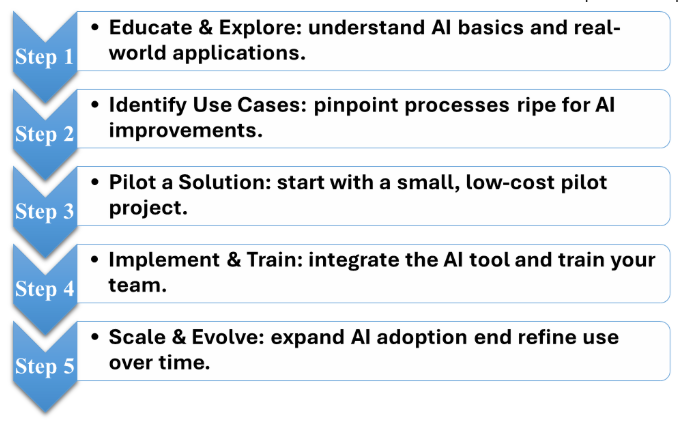A few years ago, AI was an elite technology—expensive, experimental, and largely confined to Silicon Valley giants. Today, it’s quietly reshaping the way small businesses operate, compete, and grow. A 2024 analysis by the U.S. Chamber of Commerce found that 98% of U.S. small businesses utilize at least one AI-powered tool in their operations. From automating mundane tasks to gleaning data-driven insights, AI is enabling small and mid-sized businesses (SMBs) to “punch above their weight” and compete with larger firms.
However, this opportunity comes with challenges. Adopting AI has become urgent to remain competitive, yet many business owners struggle with a lack of hands-on AI education and practical training resources. This report will examine how the growing accessibility of AI is benefiting small and medium-sized businesses. It will encompass the diverse forms of AI applications in use, the competitive imperative to adopt AI, real-world success stories, and strategies to bridge the knowledge gap, enabling small businesses to fully leverage AI’s potential.
AI Becomes Affordable and Accessible for Small Businesses
Over the last two years, the cost of AI tools and services has decreased significantly, creating genuine opportunities for small businesses to deploy intelligent solutions at scale. For example, OpenAI’s state-of-the-art language model GPT-4 saw a 78% price reduction in its API costs within one year (2023–2024). OpenAI has reduced its prices over a dozen times since 2020, striving to make advanced AI “affordable for every business, from the largest enterprises all the way down to mom-and-pop shops.” The result is that many AI capabilities – from natural language chatbots to image recognition – are available as pay-as-you-go cloud services or even free basic tools.
AI’s growing accessibility means small firms can now use the same kind of intelligent automation once reserved for Fortune 500 companies. Many software platforms that SMBs already use, such as accounting, e-commerce, and marketing tools, have quietly integrated AI features. This explains why nearly every small business today uses some form of AI, even if indirectly. Importantly, AI is not a monolith. It also includes simpler machine-learning algorithms, rule-based decision systems, and robotics. Modern AI encompasses a range of applications, from advanced predictive analytics to straightforward process automation, and all these forms are increasingly within reach for smaller enterprises. As the U.S. Small Business Administration (SBA) advises, many AI tools now offer basic services for free or at a low cost, allowing business owners to experiment on a small scale before making a full commitment. Thus, AI is becoming a standard business resource that is as accessible as an internet connection.
AI Applications Tailored for SMBs
One misconception is that AI is limited to complex neural networks or sci-fi robots. In reality, small businesses are successfully using a wide variety of AI technologies to solve everyday problems. Table 1 highlights some of the key types of AI tools and practical use cases for SMBs:
Table 1 : Types of AI tools and example use cases for small businesses
| Type of AI Tool | Small Business Use Case & Benefits |
| Chatbots & Virtual Assistants (Natural Language Processing) | 24/7 customer service on websites and social media, answering FAQs and routing inquiries without human staff.
For example, an e-commerce boutique can deploy an AI chatbot to handle common customer questions and orders around the clock, improving responsiveness and freeing up employees for complex issues. |
| Predictive Analytics (Machine Learning) | Forecasting trends and solving problems before they happen.
A small retailer can utilize AI-driven analytics to forecast inventory needs or identify potential supply chain delays, thereby avoiding stockouts or delivery issues. AI pattern recognition also helps entrepreneurs analyze sales data to make more informed strategic decisions, such as identifying peak purchasing periods or customer segments to target. |
| Process Automation (RPA & AI Integration) | Automating repetitive administrative tasks that used to eat up hours. Examples include automatically sorting and responding to emails, scheduling social media posts, updating calendars, and even reordering inventory when levels are low. Such AI-powered automation enables small teams to “do more with less” by efficiently handling back-office tasks without the need for additional hires. |
| Generative AI for Content (Text & Image Generation) | Producing marketing content, designs, and documents at scale.
Small marketing teams use tools like GPT-4 or other AI writers to draft blog posts, product descriptions, or even business plans from simple prompts. Similarly, AI image generators help create professional-quality graphics or product photos without the need for expensive photo shoots. These tools enable even non-technical founders to create polished content and campaigns that rival those of larger firms. |
| Data Analysis & Decision Support (AI-powered BI) | Turning raw data into actionable insights.
AI systems can quickly sift through a small business’s customer data, financial figures, or market research and highlight trends or anomalies. For instance, a café or a family-run shop can utilize AI analytics to identify which customer demographics drive the most sales and tailor their marketing accordingly. By serving as an “analytical brain,” AI helps owners make evidence-based decisions rather than relying on gut feel |
Source: author’s development
These examples demonstrate that AI encompasses various techniques that small businesses are already utilizing in different functions, ranging from customer-facing chatbots to back-end data analysis. Crucially, one doesn’t need a PhD in machine learning to deploy these solutions; many are available as off-the-shelf services or add-ons to existing software. As the SBA notes, AI can assist with everything from improving customer service and marketing to optimizing operations and even generating new ideas for your business. In practice, a small enterprise might start by using a voice assistant to schedule meetings, then add an AI plugin to help draft emails, and possibly later utilize a machine learning tool to forecast sales, gradually integrating AI into multiple aspects of the business. The key is that AI is flexible: whether it’s a simple rule-based automation or a cutting-edge generative model, what matters is choosing the right tool for the task at hand.
Adopting AI to Stay Ahead
With AI tools becoming increasingly ubiquitous, there is a growing urgency for small to medium-sized businesses to adopt AI or risk falling behind. Early adopters are already reaping competitive advantages. Research consistently shows that small companies that fully embrace technology outperform their peers in terms of growth and optimism. In a nationwide survey, 91% of small businesses using AI reported that it would help their business grow in the future. These firms are using AI to operate faster, smarter, and leaner – essentially leveling the playing field with larger competitors. As one industry leader put it, AI allows small businesses to “compete faster and smarter – a huge benefit for a small business.” Conversely, businesses that ignore these tools may find themselves at a disadvantage, as customers come to expect the efficiency and personalization that AI can enable, such as instant customer support or data-driven recommendations.
Adopting AI is quickly shifting from a novelty to a necessity. A 2024 Chamber of Commerce report highlighted that small businesses fully embracing emerging technologies, such as AI, are growing and achieving success on a larger scale, effectively outperforming their market share. It’s telling that 77% of small business owners plan to adopt new technologies, including AI, in the near term – a sign that the majority recognize the critical importance of tech adoption for staying competitive. The payoff is tangible: in Colorado, a tech-forward state, 84% of small businesses that implemented AI have expanded their workforce and reported profit growth. Rather than AI eliminating jobs, these firms found that automating routine work and gaining better insights allowed them to grow more, hire more, and increase revenues.
Equally important, AI can help small companies remain agile in challenging environments. During the recent inflationary period, nearly four in five small businesses reported that using technology helped them avoid raising prices for customers despite rising costs. Efficiency gains from AI – reducing waste, optimizing inventory, streamlining customer acquisition – translate into cost savings that can keep a business competitive on pricing. Speed is another competitive dimension: AI tools can drastically reduce response times and decision cycles (for example, generating a data report in minutes rather than days, or instantly engaging a web visitor via a chatbot). In an economy where customer expectations are high and larger companies are quick to adopt new tech, small businesses cannot afford to sit on the sidelines. Forward-thinking entrepreneurs, such as Austin Milliken, founder of a boutique investment bank, argue that it is “vital for companies to start embracing AI…if they want to remain competitive.” The bottom line: AI adoption is quickly becoming a standard ingredient for business success, and the sooner SMBs integrate these tools, the better positioned they will be in their respective markets.
Real-World AI Use Cases in Small Businesses
To appreciate how AI can positively impact small businesses, let’s consider a few real-world case studies of entrepreneurs who have put AI tools to work in creative, results-driven ways:
Table 2 : Real-World AI Use Cases in Small Businesses
| Business Name & Location | AI Applications Used | Impact / Outcomes |
| Henry’s House of Coffee – a family-owned coffee roastery (San Francisco, CA) | SEO with AI-generated product descriptions, customer analytics, and chatbot assistants for multi-role interactions. | Improved targeting and personalization; more data-driven marketing; operates efficiently in a competitive market. |
| Something Sweet Cookie Dough – a small, family-run gourmet cookie dough manufacturer (Gainesville, FL) | ChatGPT for content creation, Shopify AI for inventory and finance, AI sensors in manufacturing, and an AI-powered FAQ video assistant. | Expanded reach and shipping capabilities; reduced waste; scalable operations with a lean team. |
| SodaPup – a pet supply small business that manufactures dog toys (Denver, CO) | AI text generation for marketing, AI chatbot for customer service, and AI-enhanced product photography. | Sustained strong online presence; enhanced customer engagement; scalable growth without team expansion. |
| CarGari – a peer-to-peer car rental startup (Denver, CO) | AI image enhancement for marketing, automated bookings, and customer interaction via AI systems. | 24/7 customer service with minimal staff; professional marketing output; competitive agility against larger platforms. |
Source: author’s development
Each of these success stories highlights different AI tools – from chatbots and content generators to analytics platforms – applied in varied industries. The common thread is that AI helped these small businesses achieve results that would be hard to attain otherwise, whether it’s scaling up output without scaling costs, personalizing marketing as effectively as a big-budget firm, or offering services (like 24/7 support) that generally require a large staff.) Real data underscores these anecdotes: for instance, in tech-friendly Colorado, 42% of small businesses are already using generative AI to level the playing field with larger competitors, and a striking 84% of AI-adopting small businesses have seen workforce expansion and profit growth as a result. These successes are encouraging more entrepreneurs to explore what AI can do for their operations.
Making AI Adoption Feasible for SMBs
While the benefits of AI are compelling, many small businesses face a significant hurdle: a lack of accessible, hands-on AI education and training. Traditional AI courses and materials often skew academic or are geared toward software engineers, leaving business owners overwhelmed with jargon or theory. The reality on the ground is that knowledge, not willingness, has become a primary barrier to AI adoption for small firms. According to a survey by the Bipartisan Policy Center, over 50% of small business owners cited a lack of knowledge about which AI tools to use as their top concern, and nearly as many were concerned about their employees’ lack of digital skills. Additional costs in training staff (raised by 46% of respondents) and uncertainty about how to implement AI also ranked high among the barriers. Thus, many small businesses want to adopt AI but are unsure how to start or where to obtain practical training.
This education gap has not gone unnoticed. Even policymakers are responding to the need for more hands-on AI training tailored to small and medium-sized businesses. In the U.S., a bipartisan bill – the Small Business Artificial Intelligence Training Act of 2024 – was introduced to direct the Department of Commerce to develop AI training resources for small businesses, especially in rural or underserved communities. The fact that Congress is mandating the creation of such resources underscores the current lack of accessible education in this area. Similarly, the Bipartisan Policy Center’s survey found that 34% of small businesses would find “technical assistance and training resources” on using AI helpful, and over two-thirds were interested in programs such as SBA loans to fund AI adoption and training. Clearly, there is demand for practical guidance: owners are looking for playbooks on how to implement AI in daily operations, not just high-level talks on algorithm design.
So, how can the AI learning curve be made easier for small business professionals? One approach is through better outreach and modernization of existing support programs. Many governments and industry groups do offer resources – for example, the SBA’s website now includes guidance on AI for small businesses – but uptake has been low. Participants in policy roundtables noted that many owners are unaware of federal technical assistance programs or find the content outdated and not relevant to current AI tools. Refreshing these programs with up-to-date, hands-on content (and actively marketing them to the SMB community) could significantly improve knowledge transfer. Local business associations and chambers of commerce are also stepping up, with workshops, webinars, and demo days focused on AI for small businesses becoming increasingly common. For instance, chambers in tech-forward regions, such as Denver (as seen in the success stories event), are hosting events where small business owners can witness AI demonstrations and share their experiences. Peer learning is invaluable – small companies learning from other small companies about what works, and can supplement more formal training.
Finally, small businesses can take incremental, self-driven steps to build AI competency. Rather than diving into complex AI development, experts suggest starting small: begin with a modest pilot project or experiment with a free AI tool in one area of your business. This approach allows the team to learn by doing, gain quick wins, and build confidence. For example, you might task your team with using a free chatbot builder to automate one FAQ page, or use an AI scheduling assistant for a month and evaluate the time saved. These low-risk trials serve as hands-on education. Over time, as comfort grows, the business can expand AI usage to other processes – essentially creating its own on-the-job training program. The diagram below outlines a simple roadmap for AI adoption that many small businesses can follow, balancing learning with gradual implementation:
Picture 1: AI adoption road-map

Source: author’s development
By following a structured adoption roadmap and leveraging emerging training resources, small businesses can overcome the knowledge gap. The key is to make AI adoption a learning process: start with achievable projects, use available guides (from the SBA or industry peers), and iterate. As a report concluded, “small businesses that use AI are seeing increased growth and profitability, and are better equipped to compete.” With the proper support and education, even more small to medium-sized businesses (SMBs) can share in that success.
AI and the Future of Small Business
Artificial intelligence is proving to be a powerful ally for small businesses, not a threat. What was once the domain of large corporations with substantial IT budgets is now increasingly accessible to smaller organizations, thanks to lower costs and user-friendly AI solutions. We’ve seen that AI can boost efficiency, cut costs, enhance customer experiences, and open up new opportunities for innovation in a small business context. Just as importantly, we’ve seen that many small firms are already harnessing AI – from coffee roasters to craft manufacturers – and they are often growing faster, reaching more customers, and holding their own against larger competitors as a result. In an economy where agility and insight are at a premium, AI provides the tools to make better decisions and automate tasks that can be automated, allowing business owners to focus on creativity and strategy.
That said, realizing AI’s positive impact across the small business sector will require closing the current gaps in awareness and skills. It’s encouraging to note initiatives like federal training programs in the works, and the fact that entrepreneurs themselves are actively seeking practical knowledge on AI. Industry associations, government agencies, and tech providers all play a role in demystifying AI and making it approachable for the average business professional. The trend is clear: the SMBs that embrace AI tools early will have a head start in productivity and customer engagement, whereas those that delay may find themselves playing catch-up. However, with AI becoming increasingly accessible by the day, no small business should be left behind. By starting small, learning continuously, and leveraging the growing ecosystem of affordable AI solutions, even the smallest of companies can harness the power of artificial intelligence – and in doing so, secure their place in the future economy.
Sources:
- U.S. Chamber of Commerce – “New Study Reveals Nearly All U.S. Small Businesses Leverage AI-Enabled Tools, Warns Proposed Regulations Could Hinder Growth” (Sept 2024) https://www.uschamber.com/technology/artificial-intelligence/new-study-reveals-nearly-all-u-s-small-businesses-leverage-ai-enabled-tools-warns-proposed-regulations-could-hinder-growth
- U.S. Chamber of Commerce – Jordan Crenshaw, “AI Is Transforming Small Business: A Colorado Success Story” (Dec 2024) https://www.uschamber.com/technology/artificial-intelligence/ai-is-transforming-small-business-a-colorado-success-story
- U.S. Chamber of Commerce – Jordan Crenshaw, “Enhancing Entrepreneurship: AI’s Big Impact on Small Business” (May 2024) https://www.uschamber.com/technology/artificial-intelligence/enhancing-entrepreneurship-ais-big-impact-on-small-business
- Bipartisan Policy Center – “Small Businesses Matter: Navigating the AI Frontier” (Apr 2024) https://bipartisanpolicy.org/report/small-businesses-matter-navigating-the-ai-frontier/
- U.S. Small Business Administration – “AI for Small Business” (SBA.gov, accessed 2025) https://www.sba.gov/business-guide/manage-your-business/ai-small-business
- Inc. Magazine – Ben Sherry, “Why OpenAI’s API Chief Is Eager to Slash Prices” (Oct 2024) https://www.inc.com/ben-sherry/exclusive-why-openais-api-chief-is-eager-to-slash-prices/90982047
- Congressional Budget Office – “Cost Estimate for S.4487 Small Business AI Training Act of 2024” https://www.cbo.gov/publication/60670
































